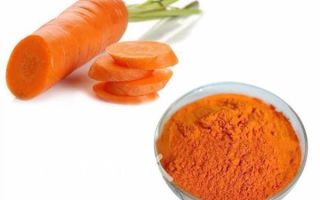Content
Many are of the opinion that if a product contains stabilizers and preservatives, then its use is harmful to the body. But this is not entirely true. There is a food additive E160a, under the name of which a natural dye, beta-carotene, is hidden.
What kind of additive is E160a
Food supplement E160a belongs to the category of carotenes and is considered one of the safest. The substance is an unsaturated carbohydrate. Produced in powder form with small crystals. Has an orange color. There is no smell. It does not dissolve in water, but goes well with fats, benzene, chloroform, ether.
E160a does not decompose even after prolonged exposure to air. Shows sensitivity to bright light and heat. In rare cases, it ignites on its own. Resistant to acids.
Beta-carotene is produced not only in powder form, but also in liquid form. The solution is packaged in containers. The dry additive is distributed in packages of different sizes.
What is the food additive E160 made of?
Food additive E160a belongs to the group of unsaturated hydrocarbons. There are 2 types of preservative - natural and synthetic origin. The first type of carotenes is obtained from foods - carrots, corn, palm oil.
A substance of synthetic origin is produced as a result of chemical reactions, the source of which is natural components. Manufacturers in Australia make the substance from dried algae, and the Spanish get an orange powder from mushrooms.

The benefits and harms of E160a dye
The positive effect of the food additive E160a on the body has been talked about for a long time. This substance is good for hair and skin. Carotenes have an antioxidant effect, due to which they actively fight free radicals and reduce the risk of cancer. Also, carotene helps to make the tan beautiful and even.
Food supplement E160a relieves skin dryness, early appearance of wrinkles, acne. Normalizes hair condition. Reduces the risk of developing colds.
There is a persistent opinion among people that beta-carotene is a good prevention of cancer pathologies. But scientists from the United States have denied these properties.
E160a is not a prohibited additive, therefore it is used in the USA, Russia, Canada, Australia and other countries of the world.
E160 food additive is dangerous or not
Food supplement E160a is not recommended to be given to children under 3 years of age. Studies have been carried out, from which it turned out that the substance causes dermatitis and other diseases of the skin.
The additive has the ability to accumulate in the subcutaneous fatty tissue. After entering the body, carotene turns into vitamin A. It comes out with feces.
Despite this, the fiber becomes yellowish. If a person consumes a lot of products with the E160a food additive, then the skin gradually becomes yellow.This indicates an overdose, against the background of which poisoning occurs.
The substance does not pose a serious danger to the body, since it is obtained from natural components - vegetables, oils, algae or mushrooms.
Scientists have carried out numerous studies. They found that smokers who use carotenes are more likely to suffer from heart cancer. You can avoid the occurrence of pathology if you observe the daily dose.

Where and why is E160a dye added?
Carotenes are most often used to color food. The food additive is added to such products:
- butter;
- margarine and spread;
- mayonnaise;
- processed and hard cheese;
- pasta;
- bakery products;
- sweets;
- carbonated drinks, juices and syrups;
- semi-finished products;
- fast foods;
- chips.
In the food industry, it is customary to use carotene not in pure form, but in commercial forms. The thing is that in this way it is easier to dose them, and they do not require special storage conditions.
The dye exhibits high thermal stability. It allows you to keep the color up to 150 degrees. Shows good acid resistance, therefore it is often added to juices. Due to the presence of ascorbic acid in liquids, it is possible to obtain a stable color.
Food supplement E160a is used in other areas as well. The dye is added to a number of pharmaceuticals, vitamin complexes. Also, carotene is present in cosmetics. The powder is used for the preparation of oils, since it dissolves well in them.
Conclusion
Food supplement E160a is considered one of the safest supplements for the body. The dye is not harmful if the daily dose is observed. This is due to the fact that natural ingredients are used in the manufacture. The additive is introduced not only into food, but also into cosmetics and medicines. Despite all the safety of the substance, poisoning may occur against the background of frequent consumption of yellow and orange foods. Then the person will complain of the manifestation of unpleasant symptoms in the form of nausea, diarrhea, yellowing of the skin.

